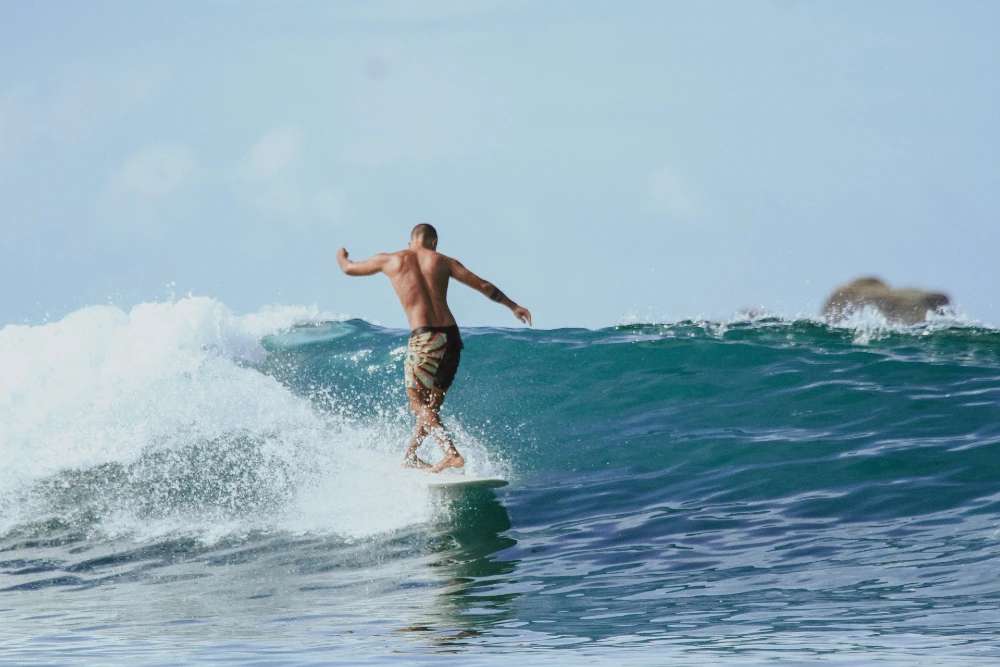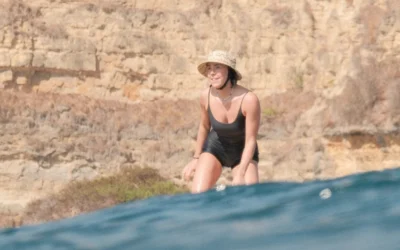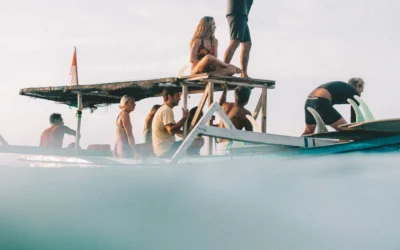Longboard Surfing / How Is It Different From Other Types of Surfing?
New to the world of surfing and find yourself perplexed by all the weird and wonderful surfboard shapes available? Welcome to the club! If you’ve recently caught the surfing bug, you might have noticed that boards come in all shapes and sizes.
At Xanadu, we’re longboard surfers, which means we ride longer boards and surf smaller, gentler waves that are more suited to this cruisy style of surfing.
What exactly do we mean when we say “surfing a longboard” though? In this article, we’ll tackle this question and compare longboards to shortboards, which are another very popular surfboard type.
Then, with any luck, you’ll know almost everything there is to know about becoming a longboard surfer once you’ve finished reading. So read on and enjoy learning all about:
- The history of longboarding
- The different types of longboards
- The difference between longboards and shortboards
The history of longboarding
The origin of longboarding
Longboarding has its roots firmly planted in the ancient Hawaiian tradition of he’e nalu, known in English as ‘wave sliding’.
The sport was originally practised by the indigenous people of Hawaii long before Europeans set foot on the islands. These early longboards, called olo by the Hawaiians, were heavy, cumbersome and required immense skill to operate.
Olo boards were also used exclusively by the Hawaiian royal class, with commoners riding a shorter and thinner board called an alaia.
Longboarding into the 20th century
Fast forward to the 20th century and longboards are the dominant type of board from the early 20s through to the 60s.
Aptly named the ‘Golden Age of Surfing’, this era saw the explosion of longboard culture and technological improvements (specifically fins and materials), with surf movies, personalities and music fueling its popularity across the globe.
Surf legends like Duke Kahanamoku and Greg Noll became household names, riding their longboards on the majestic waves of Waikiki and Malibu, while bands such as The Beach Boys helped proliferate the longboarding culture both in California and throughout the rest of the world.
The revival of longboarding
The advent of shorter boards in the late 60s led to a temporary decline in the popularity of longboarding, with shortboards becoming the prevalent surfcraft in lineups.
Since the 90s, however, longboarding has been making a strong comeback, with boards becoming lighter and easier to ride. This has opened up the sport to a whole new generation of surfers seeking an alternative way to experience the joys of riding waves.
Longboarding is now recognised as its own distinct style of surfing, and there are even some competitive events held in the longboarding discipline.
The different longboard types
While we don’t want to make this article too complicated, it’s important that we touch on the different longboard types you’ll come across when exploring the sport.
The classic longboard (Malibu or log)
The classic longboard (otherwise known as the Malibu or Log) is the quintessential longboard type for cruising around on small to medium waves.
It’s often 9 feet or longer in length with a rounded nose and very wide tail which allows it to paddle easily and glide gracefully on the waves. These are the type of boards that we specialise in riding at Xanadu.
The modern longboard
The modern longboard is shorter than the classic, usually between 7 to 9 feet in length.
It’s designed for more advanced surfers who want to execute radical manoeuvres with a bit more speed and agility than a classic log. Modern high-performance longboard shapes are generally ridden in competitions.
The mini mal longboard
The mini mal is somewhere in between classic longboard types and modern ones. It’s usually 7 to 8 feet in length with anywhere from one to three fins.
Mini-mals are a great longboard type for beginner surfers since they are small enough not to feel unwieldy but they still have fantastic buoyancy, which is crucial for paddling and catching waves.
Longboards vs. shortboards / What’s the difference?
When defining longboarding, it helps to compare it to another popular type of surfboard – the shortboard.
As the name suggests, shortboards are just that – shorter boards usually ranging from 5 to 7 feet in length. The main distinction between these different boards is the type of waves they can be ridden on. Longboards are better suited for small, gentle waves, while shortboards excel in larger, steeper, more powerful surf.
Here are a few more key distinctions between a longboard and a shortboard.
Surfboard shape/materials
A longboard usually has a wider nose and broad tail, with anywhere between one and three fins depending on the type of construction.
Due to the fact that most longboards are around 9 feet, they’re also incredibly buoyant and therefore easy to paddle and catch waves on. A longboard can be made from polyurethane foam wrapped in fibreglass, however, you will also find balsa and paulownia wood longboards available for sale.
Shortboards, on the other hand, are much shorter and narrower with a pointed nose. They often have three or four fins and tend to be made from lightweight materials such as polyurethane foam, epoxy resin or carbon fibre.
Surfing style
The different styles when it comes to surfing a longboard and surfing a shortboard are dramatic.
Whereas longboarders tend to favour a more traditional, graceful style using fluid carves and manoeuvres, shortboarders tend to go for faster, more radical moves like aerials and snaps.
A longboard is also great for noseriding (standing on the nose of the board while riding a wave), which is virtually impossible to do with a shortboard. You can also perform cross-stepping on a longboard – something that’s taught during our Special Longboard Week.
In saying that, shortboarders can negotiate steeper waves and get deeper and longer barrels, which is the act of positioning yourself and your board within the curl of the wave.
Wave type
Longboarders can surf shortboard waves and vice versa, but each type of board has its own respective wave preferences.
Longboarders tend to opt for small, mellow waves since their boards are designed for cruising and carving.
On the other hand, shortboards work best in larger surf with more intensity as this allows them to perform all sorts of radical manoeuvres that simply aren’t possible on a longer board.
Point breaks such as The Pass in Byron Bay, Lombok’s Gerupuk and Malibu in California are all great spots for a longboard. Shortboarders, meanwhile, flock to places like Supertubos in Portugal, Pipeline in Hawaii and Teahupo’o in Tahiti.
Longboarding FAQ
What is a longboard?
A longboard is the quintessential type of surfboard for cruising around on small waves to medium waves. It’s usually 9 feet or longer in length with a rounded nose and very wide tail, designed to provide stability, buoyancy and an easy ride.
Is it easier to surf on a longboard?
Yes, depending on the type of wave you are trying to ride, a longboard can be easier to surf due to its stability and buoyancy. They are also excellent for teaching beginners as they provide a stable platform from which to learn the basics.
What are the main differences between a shortboard and a longboard?
The main differences between a longboard and a shortboard are the size (longboards are usually around 9 feet, while shortboards range from 5 to 7 feet), the board shape (longboards have a rounded nose and wide tail, while shortboards have more of an arrowhead shape) and wave preference (longboards tend to perform well in small, mellow waves while shortboards excel in steeper, more critical conditions).
Are there different longboard types?
Yes, there are a few different types of longboard. These are the classic longboard (otherwise known as the Malibu or Log), the modern longboard and the mini mal.
Each type of board is designed for different types of surfing – from beginner cruising down to advanced high-performance manoeuvres. At Xanadu, we match you with the right board that suits your skill level and wave type.
Which type of longboard is easiest to ride?
This depends on your skill level, but assuming you’re a beginner, the easiest type of longboard to learn on is one that you feel most comfortable with.
In our opinion, learners can easily master the basics on a classic longboard shape that’s around 9 feet long. You can then move on to a mini mal or modern longboard when you feel more confident in small waves and know a few surf safety tips.
Conclusion
Longboard boards are a great way to surf small to medium waves and perform more graceful manoeuvres.
They’re also a fantastic option for beginner surfers, as longboards are incredibly buoyant and stable, allowing them to learn the basics without feeling overwhelmed.
If you’re looking for an easy-riding board that will get you out in the water and standing up quickly, then a longboard is definitely the way to go.
Fortunately for you, we stock a great range of longboards for you to ride at our camp. This means you needn’t lug a longboard all the way to Indonesia – there’s a beautiful one already here… waiting for you!




